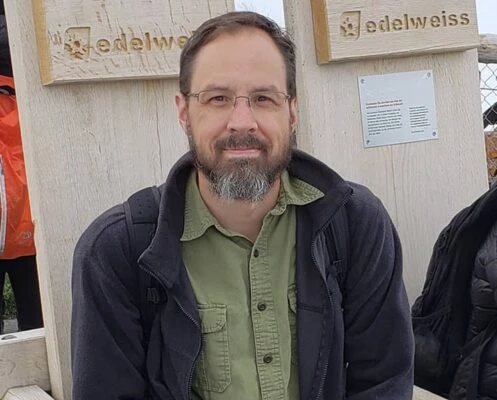
This month’s cover artist for Apex Magazine is Irek Konior, a Polish illustrator and artist. The beautifully painted, layered work on this month’s cover is just one aspect of Konior’s varied styles and wonderful creative abilities.
APEX MAGAZINE: Your art for this month’s Apex Magazine cover has a strong layered effect, bringing a dimensional feeling to the piece. How difficult is that dimensional style to create, compared to more traditional pieces? When you’re working with textures and overlays, do you have a specific final look in mind, or do you experiment more with it?
IREK KONIOR : In the very beginning of work I have only a basic view of the cover. More like black and white shapes, and I experiment with layers and blendings to achieve this more dimensional look ofthe picture. Sometimes this way gives unexpected results hard to create in traditional way.
It’s quite fun too. It isn’t more difficult than traditional piece and, in many cases, the quicker way for me.
AM: The pieces in your website galleries range from photographic to ink and other illustration styles. Do you find yourself more interested in a particular medium overall, or does it depend on the specific piece?
IK: First of all, I’m a comic artist. Other stuff, like covers or book illustrations, are very intriguing and tempting but drawing comics pleases me most.
AM: The Covers section of your website features art you’ve done for various authors and books. How much of the book to you get ahead of time to prepare for the art? Do your ideas typically feature a scene from the book, or do you look more to represent the whole story in a cover image?
IK: Sometimes I don’t need to read a whole book to begin the cover. (With the exception of the case when book is very interesting to me). When I was working on cover to Peter Watt’s Blindsight, I had a plan before reading the book. I had a general knowledge of the plot and contents, and it turned out that I was right: the image fit to the story. After that, I read whole book and I liked it so much.
Rather than featuring one scene, I try to represent rather a whole story of the book. I tend to do more symbolic covers like Gaiman’s American Gods or Shepard’s Griaule.
AM: Many of your pieces seem to tell a story, or represent an idea that could easily lead into a full story idea. Are your pieces based on already existing stories, yours or otherwise, or are storytelling ideas more a style that you’ve adopted?
IK: In the case of comics, mostly I invent the story, though sometimes I draw stories written by my wife. Today I work on one longer comic, a sf-western, where the background is the world destroyed after a war between Indians and American Army. Old Indian demons and big robots fight together. In this strange world, four heroes look for their lost friends.
The second shorter comic, written by my wife, talks about cats who try to stop a factory demolition because this factory was a favourite playground for them.
Moreover I draw black and white moody comics—horror about girls who were lost in a mountain and finally get to the ghost town.
I hope for soon publish these stories in Poland and France and, if possible, maybe in the US.
Also, in single illustrations, I like create the background which is hidden behind the image.
AM: Your comics seem to have a consistent style of their own, somewhat different that your other pieces. Are those pieces influenced by other artists and creations you’ve seen? How does working on a comic piece differ in general from a cover art piece or illustration?
IK: I prefer to draw comics with traditional techniques like the ink and paints to computer techniques, which are faster but not so satisfactory. Here I don’t have to strive to more realistic images so I have larger scope for expression. Daisuke Igarashi, Claire Wendling, Bezian, Junji Ito, Nihei, and many others inspired me.
When working with comics, I have to think about the composition of all the images on the site and check to see if characters or important elements don’t create a strange flow, which could spoil whole. There are more elements to think than in one single image, like working on a cover or illustration.
Irek Konior continues to make new comics and book cover illustrations, as well as original paintings. See more of Konior’s work on his website at ikonior.wix.com/ikonior.









